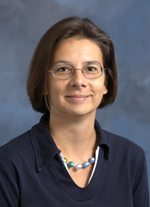As nation seeks to solve obesity epidemic, 'food deserts' emerge as a possible factor for weight gain
July 22, 2011

At a news conference in the East Room of the White House, First Lady Michelle Obama recently announced that many retail stores will be expanding to areas considered "food deserts," places that have limited access to stores with healthy food options. (Official White House Photo)

Arnold School epidemiologist Dr. Angela Liese is leading a study on "food deserts" in an eight-county area of South Carolina.
In a nation whose landscape is dotted with fast food restaurants and retail chains offering food items and household goods, it's hard to imagine that many communities are considered "food deserts" – a designation that factors in a region's size, population and access to grocery stores.
Yet, many areas in the rural South are "food deserts," according to the U.S. Department of Agriculture, and a grant to the Arnold School of Public Health will examine an eight-county area in South Carolina to determine whether these areas match the federal designation.
The study will be led by Dr. Angela Liese, a professor and director of the Center for Research in Nutrition and Health Disparities at the University of South Carolina's Arnold School of Public Health.
"A food desert doesn't mean that access to food is difficult. It means that access to healthy, affordable food choices, especially fruits and vegetables and whole-grain, dairy and lean meat selections, is difficult because people don't have supermarkets and grocery stores nearby," she said.
"Limited access to healthy foods in low-income, rural areas is a contributor to obesity, cardiovascular diseases, diabetes and other nutrition-related diseases," Liese said.
The USDA estimates that 23.5 million people, including 6.5 million children, live in food deserts.
The one-year study draws on the expertise of Liese and other Arnold School researchers who have been studying food access in South Carolina's rural areas for about eight years. The $33,000 grant is from the Research Innovation and Development in Economics (RIDGE) Center of the Southern Rural Development Center at Mississippi State University. The counties being studied in South Carolina are Richland, Orangeburg, Calhoun, Clarendon, Kershaw, Fairfield, Chester and Lancaster.
"This grant is a good fit with the ongoing U.S. policy initiatives to improve access to healthy food choices," Liese said. "We want to know whether these policies are making a difference."
The grant also is timely.
First Lady Michelle Obama announced July 20 that she is working with retail stores to improve healthy food options in the nation's "food deserts." Walmart, for example, has said it will open 300 stores in food deserts over the next five years, and the pharmacy chain Walgreen's is committed to adding fresh produce to its existing and future stores.
Speaking at a July 20 news conference in Washington, D.C., Mrs. Obama said more must be done to help parents make good choices for their families.
"… they should have fresh food retailers right in their communities -– places that sell healthy food at reasonable prices, so that they can feed their families in the way that they see fit, because when they have those choices, that can have a real, measurable impact on a family's health, and we all know that," said Mrs. Obama, who is leading the "Let's Move" campaign to encourage physical activity among children and families.
"Studies have shown that people who live in communities with greater access to supermarkets eat more fresh fruits and vegetables, and they have lower rates of obesity," she said.
The Arnold School already has accumulated significant data on food deserts and the food environment in rural areas of the Palmetto State through the work of individual researchers and the Center for Research on Nutrition and Health Disparities, Liese said.
"This grant will build on our previous studies and offers us the opportunity to add to the growing body of scientific knowledge on nutrition in our nation," she said.
Other USC researchers working on the study include Dr. Sarah Battersby from the Department of Geography and Dr. Bethany Bell from the College of Education.



_01.jpg)
_02.jpg)